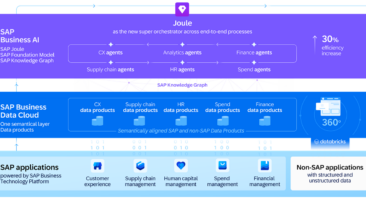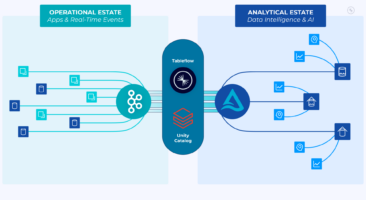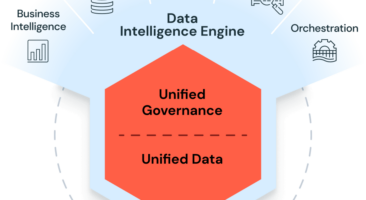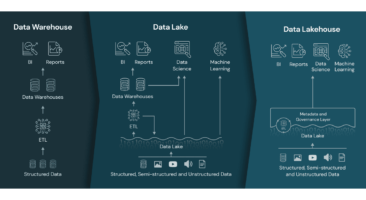Why Data-Centric Architecture is Important for Your Organization
Data is essential in today’s digital economy, enabling companies to make informed decisions and drive growth. A data-centric architecture is therefore necessary if businesses hope to remain competitive and thrive. This blog post examines data-centric architecture, its importance, and its implementation processes. Plus, we’ll present case studies of how such solutions have helped businesses prosper – so read on if you are an IT decision-maker looking for data integration and process automation solutions!
What is data-centric architecture?
Data-centric architecture organizes data to meet specific business requirements rather than on any particular system or application. As a result, it offers a holistic view of an organization’s data, facilitating smooth processes and improved decision-making capabilities.
Data-centric architecture can lead to increased efficiencies, more accurate reporting, and overall improved performance in organizations looking to optimize their information management strategies.
Businesses seeking to build data-centric architectures should first establish clear definitions for all their data types, then ensure all systems and applications are designed with this view in mind. Adopting such an approach results in improved efficiencies, more accurate reporting, and overall performance for organizations looking to optimize their information management strategies.
Definition
Understanding the concept of data-centric architecture is crucial for modern organizations. This approach prioritizes data as the central focus throughout all processes, from storage to analysis. Unlike traditional data management methods, such as application-centric or process-centric views, a data-centric architecture ensures consistent and accurate information across various applications and systems.
Key features and principles of this architecture include:
- A single source of truth for all data.
- Flexible integration with different applications.
- An emphasis on governance and security.
Organizations can streamline their operations by adopting a data-centric view while reducing redundant or conflicting information costs. Ultimately, this approach empowers decision-makers with reliable insights that drive business growth.
Characteristics
Scalability is one of the critical characteristics of a data-centric architecture (DCA). A DCA can handle large volumes of diverse data sources without impacting performance or productivity, allowing your organization to efficiently store and process large volumes of structured and unstructured information from different sources.
Flexibility is another hallmark of DCA that sets it apart from more traditional architectures. Its ability to adapt quickly to shifting business needs with minimal disruption makes it an attractive solution for organizations searching for agility in operations. Here are other features that set DCA apart:
- Data Governance: Managing the security, privacy, integrity, and compliance aspects of your organization’s data assets is critical in today’s regulatory landscape.
- Architecture-Centric: A well-designed architecture-centric approach ensures consistency across different applications and environments.
- View Management: The ability to manage views effectively provides end-users access only to the relevant parts of the system they need.
Implementing a data-centric architecture requires careful planning, but once established, it offers significant benefits, such as better decision-making capabilities through improved analytics toolkits.
Benefits
Data-centric architecture brings many advantages to organizations, especially when managing large datasets. By adopting such an approach, businesses can streamline operations while efficiently handling information flows.
Benefits of Data-Centric Architecture:
- Increased efficiency in managing large amounts of complex datasets
- Improved accuracy and quality of information for decision-making processes
- Simplified integration and automation processes across multiple systems
Businesses can better understand the relationships between different data sets with a data-centric view. As a result, it enables more accurate insights into business operations that drive better decisions. Additionally, simplified integration and automation processes mean faster execution times with fewer errors, ultimately leading to cost savings for the organization.
Why is data-centric architecture important?
Data-centric architecture is crucial for modern organizations seeking to improve data quality, enhance decision-making capabilities, and achieve scalability. Focusing on data as the core of the organization’s infrastructure enables businesses to manage large volumes of information from various sources while reducing errors and inconsistencies. In addition, with a strong foundation, IT decision-makers can integrate new tools and technologies more seamlessly into their existing systems.
Moreover, a data-centric architecture provides greater flexibility for reacting to changing business needs or market conditions. It allows organizations to develop bespoke solutions tailored to their requirements rather than relying on pre-packaged applications that may not fully meet their needs. Finally, by streamlining processes and automating routine tasks through this architectural approach, businesses can save time and cut costs in the long run while maintaining high productivity levels.
Improved Data Quality
Centralized data management allows for a single source of truth and consistent data across all departments, improving data quality. With a unified view of the organization’s data, IT decision-makers can identify inconsistencies and redundancies, eliminating errors in reporting and analysis.
Data validation and cleansing are integral parts of improving data quality. Organizations can ensure their datasets are reliable by employing automated processes that check for accuracy, completeness, consistency, and conformity with predefined rules. Real-time processing also plays an essential part in maintaining high-quality data by quickly detecting anomalies that arise and taking immediate corrective actions as they appear.
Better Decision Making
A data-centric architecture can significantly improve decision-making by providing a single source of truth for all business units. With this approach, everyone in the organization works off the same set of accurate and consistent data, reducing errors and improving efficiency.
Faster access to accurate data is another benefit of a data-centric architecture. Organizations can quickly retrieve the information they need to make informed decisions by automating processes and integrating disparate sources into a centralized repository. Unbiased insights from clean and consistent data also become possible through this approach, as it removes any biases or discrepancies when using multiple systems or manual processes.
Scalability and Flexibility
Easily accommodating changes in workload or volume of data is a critical aspect of data-centric architecture. With this approach, your organization can scale up or down as needed without disrupting the existing system. Additionally, its adaptability to new technologies and tools further enhances your ability to meet emerging business needs.
The efficient use of computing resources is another advantage offered by data-centric architecture. This approach ensures that all available resources are used optimally, reducing operational costs while maintaining maximum performance levels.
Cost Savings
Reduce manual intervention and increase productivity while avoiding costly mistakes with data-centric architecture. By automating routine tasks in data integration, preparation, and analysis, organizations can save time and money while improving accuracy. As a result, businesses can operate more efficiently and effectively with fewer errors due to incomplete or incorrect information.
With the ability to handle larger volumes of data and adapt quickly to industry or business needs changes, a data-centric architecture provides cost savings through increased scalability and flexibility. In addition, this allows IT decision-makers to focus on strategic initiatives rather than spending resources on fixing manual errors or outdated processes. As a result, investing in a solid data-centric architecture can lead to significant long-term cost savings for your organization.
Implementing data-centric architecture
Data-centric architecture is crucial for organizations to stay competitive in today’s digital age. By prioritizing data, organizations can ensure they are gathering the correct information and putting it to use effectively. Choosing the right technologies, such as data warehouses and integration tools, is essential in building an effective data-centric architecture that supports efficient decision-making processes. In addition, creating a culture around data-driven insights ensures everyone within an organization values the importance of collecting, analyzing, and using relevant information to drive success.
Prioritizing Data
Appreciating data’s role in decision-making processes to make informed decisions is crucial. It means identifying key data sources and prioritizing their integration into your organization’s data-centric architecture. Once this step has been completed, develop a plan for managing, storing, and protecting the necessary information.
Prioritizing data is essential for creating a successful IT infrastructure to drive organizational innovation and growth. With careful consideration of what information is needed most urgently, organizations can optimize their resources and ensure they are always working with the most current and relevant information available. By implementing these strategies, IT decision-makers can build a strong foundation for their company’s future success by harnessing the power of their valuable digital assets.
Choosing the Right Technologies
Selecting the appropriate technologies for your organization’s data-centric architecture implementation is crucial to its success. Start by reviewing available technologies for data warehousing and integration; evaluate each solution’s scalability, performance, and security features before selecting one that best matches your requirements.
In addition to technical considerations, other factors such as cost, vendor support, and ease of use should also be considered when selecting technology solutions. Taking the time to make informed technology decisions will ultimately lead to more efficient processes and higher-quality data outputs within your organization.
Building a Data Culture
To truly build a data culture within your organization, it’s essential to prioritize education and training. It means creating programs that teach employees best practices for collecting and analyzing data. Additionally, establish clear guidelines for accessing and using organizational data to ensure consistency across departments.
Collaboration between teams is essential for building a strong data culture. Incentivize cross-departmental teamwork by emphasizing shared goals that rely on the reliable and accurate use of the organization’s data. By prioritizing education, establishing clear guidelines, and incentivizing collaboration, your organization can develop an effective data-centric architecture that drives success in all areas of operation.
Case studies
For YZR Enterprises, implementing a data-centric architecture resulted in increased efficiency and better decision-making. By centralizing their data and automating processes, they reduced manual errors and saved time on tedious tasks. It allowed the company to focus on analyzing the data for insights that improved product development and customer experience.
AllStar Delivery also saw significant benefits from adopting a data-centric approach. They could integrate multiple data sources into one platform, providing a more comprehensive view of their operations. It enabled them to identify areas for cost savings and optimize workflows for maximum productivity. The result was a stronger competitive position in their industry.
LoadSys Solutions
LoadSys Solutions understands the importance of a data-centric architecture in today’s fast-paced business environment. Businesses can make quicker and more informed decisions by reducing data silos and streamlining processes through automated integration. Here are some benefits of implementing a data-centric architecture:
- Reduced Data Silos: A unified view of all organizational data allows for better coordination between departments, leading to greater efficiency and cost savings.
- Streamlined Business Processes: Automated integration eliminates manual errors and saves time by removing redundancy across multiple systems.
- Improved Decision Making: With real-time access to all relevant information, decision-makers can quickly identify patterns and trends to inform strategic decisions.
At LoadSys Solutions, we pride ourselves on our experience in creating solutions that leverage the power of a data-centric architecture. So let us help you unlock the full potential of your organization’s valuable asset – its data.
Conclusion
In conclusion, implementing a data-centric architecture can significantly benefit your organization’s data warehouse, integration, and process automation. By prioritizing data as the core of your operations, you can improve decision-making processes and boost overall efficiency while reducing errors. As an IT decision-maker, it’s essential to understand the importance of this approach and take action to implement it in your organization.
In summary, adopting a data-centric architecture requires careful planning and implementation but offers numerous benefits for organizations seeking to optimize their use of data. It enables streamlined workflows that deliver faster insights on market trends which helps stay ahead in today’s competitive landscape. Furthermore, it provides improved agility when making business decisions based on real-time analytics that deliver better visibility into every aspect of operation than traditional approaches could have imagined possible, all without sacrificing performance or security concerns!


















